Related Research Articles

Ustilago is a genus of approximately 200 smut fungi, which are parasitic on grasses. 170 species are accepted by Wijayawardene et al. 2020;

The Pucciniaceae are a family of rust fungi that cause plant diseases, mainly on cereals such as wheat. The family contains over 4900 species: many of them in the type genus Puccinia.
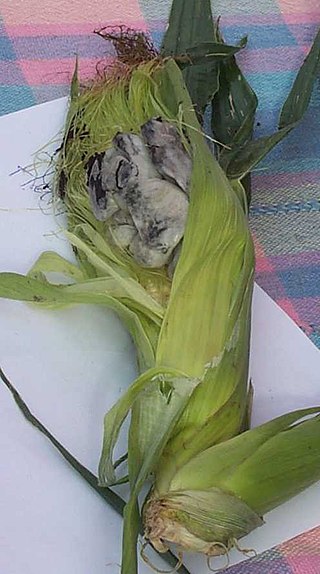
The Ustilaginales are an order of fungi within the class Ustilaginomycetes. The order contained 8 families, 49 genera, and 851 species in 2008.
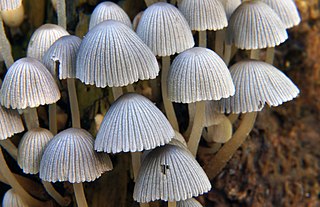
Agaricomycotina is one of three subdivisions of the Basidiomycota, and represents all of the fungi which form macroscopic fruiting bodies. Agaricomycotina contains over 30,000 species, divided into three classes: Tremellomycetes, Dacrymycetes, and Agaricomycetes. Around 98% of the species are in the class Agaricomycetes, including all the agarics, bracket fungi, clavarioid fungi, corticioid fungi, and gasteroid fungi. Tremellomycetes contains many basidiomycete yeasts and some conspicuous jelly fungi. Dacrymycetes contains a further group of jelly fungi. These taxa are founded on molecular research, based on cladistic analysis of DNA sequences, and supersede earlier morphology-based classifications. Agaricomycotina contains nearly one third of all described species of fungi.

The Botryosphaeriales are an order of sac fungi (Ascomycetes), placed under class Dothideomycetes. Some species are parasites, causing leaf spot, plant rot, die-back or cankers, but they can also be saprophytes or endophytes. They occur world-wide on many hosts. For example, in China, infections related to Botryosphaeriales have been recorded on numerous hosts such as grapes, Caragana arborescens,Cercis chinensis, Eucalyptus, Chinese hackberry, blueberry, forest trees, and various other woody hosts.
Fuscoderma is a genus of lichenized fungi in the family Pannariaceae. It was originally circumscribed as a subgenus of the genus Leioderma by David Galloway and Per Magnus Jørgensen in 1987. The same authors promoted it to generic status a couple of years later in 1989. The New Guinean species F. papuanum was added to the genus in 2002.
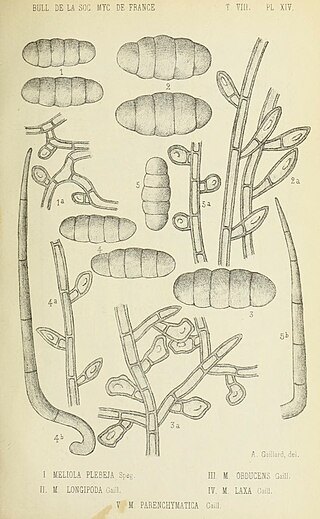
Meliola is a large genus of fungi in the family Meliolaceae. It was circumscribed by Swedish mycologist Elias Magnus Fries in 1825.
Staurolemma is a genus of lichenized fungi in the family Pannariaceae. The genus was circumscribed by German lichenologist Gustav Wilhelm Körber in 1867, with Staurolemma dalmaticum as the type species.
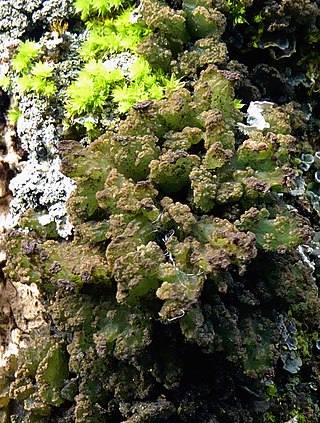
The Arctomiaceae are a family of lichenized fungi in the Ascomycota, class Baeomycetales. The family was named by Theodor Magnus Fries in 1861, with Arctomia as the type genus. Species in this family are found in arctic and subarctic habitats, usually associated with bryophytes.
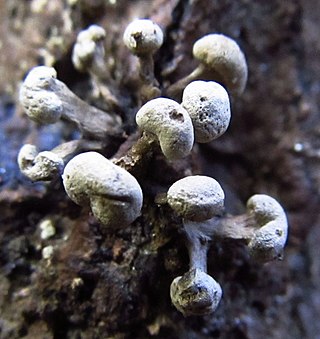
The Atractiellomycetes are class of fungi in the Pucciniomycotina subdivision of the Basidiomycota. The class consists of a single order, the Atractiellales, which contains 3 families, 10 genera, and 58 species.
The Cintractiellaceae are a monotypic, family of smut fungi, in the order Cintractiellales, but unplaced beyond that. The family contains one genera, Cintractiella with 4 species. The family was circumscribed by mycologist Kálmán Vánky in 2003.
The Websdaneaceae are a family of smut fungi in the class Ustilaginomycetes. Collectively, the family contains 2 genera and 22 species.

The Anthracoideaceae are a family of smut fungi in the order Ustilaginales. Collectively, the family contains 20 genera and 198 species. Anthracoideaceae was circumscribed by the Bulgarian mycologist Cvetomir M. Denchev in 1997.

Bulgaria is a genus of fungi in the family Phacidiaceae. The genus was circumscribed in 1822 by Elias Magnus Fries, with Bulgaria inquinans assigned as the type species.

Ustilaginoidea is a genus of fungi in the family Clavicipitaceae. The genus contains 19 species. Ustilaginoidea was circumscribed by German botanist Julius Oscar Brefeld in 1895, with Ustilaginoidea oryzae assigned as the type species. Ustilaginoidea virens causes the disesase known alternatively as rice false smut, pseudosmut, or green smut.
The Melanotaenium is a genus of smut fungi in the family Melanotaeniaceae.
Yelsemia is a genus of smut fungi in the family Melanotaeniaceae, containing four species.
Pericladium is a genus of smut fungi in the monotypic, family of Pericladiaceae in the order Ustilaginales.
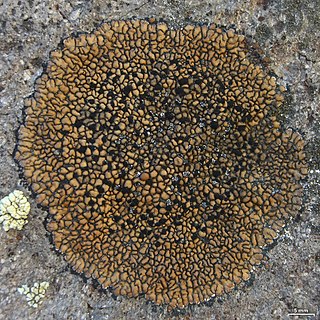
The Lecideales are an order of lichenized fungi in the class Lecanoromycetes. The order contains two families: the Lecideaceae, which contains 29 genera and about 260 species, and Lopadiaceae, which contains the single genus Lopadium of 10 species.

The Urocystidales are an order of fungi within the class Ustilaginomycetes. The order contains 6 families and about 400 genera. They are a sister order to Ustilaginales.
References
- ↑ Begerow, D.; Bauer, R.; Oberwinkler, F. (1998). "Phylogenetic studies on nuclear large subunit ribosomal DNA sequences of smut fungi and related taxa". Canadian Journal of Botany. 75 (12): 2045–2056.
- ↑ Kirk, P.M.; et al. (2008). Ainsworth & Bisby's dictionary of the fungi. with the assistance of T.V. Andrianova (10th ed.). Wallingford, Oxon, UK: CABI. p. 730. ISBN 978-0-85199-826-8.
- ↑ Wijayawardene, Nalin; Hyde, Kevin; Al-Ani, Laith Khalil Tawfeeq; Somayeh, Dolatabadi; Stadler, Marc; Haelewaters, Danny; et al. (2020). "Outline of Fungi and fungus-like taxa". Mycosphere. 11: 1060–1456. doi: 10.5943/mycosphere/11/1/8 . hdl: 10481/61998 .
- ↑ Savchenko, Kyryll; Heluta, Vasyl (January 2010). "Melanotaenium cingens (Back) Magnus (Melanotaeniaceae, Ustilaginales), a new species in Ukraine [In Ukrainian: Melanotaenium cingens (Beck) Magnus (Melanotaeniaceae, Ustilaginales) – новий вид в Україні]". Ukrainian Botanical Journal. 67 (5): 721–724.